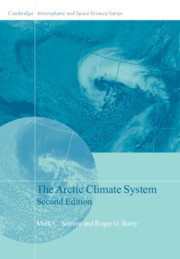Book contents
- Frontmatter
- Dedication
- Contents
- Preface
- Acknowledgments
- List of Acronyms
- List of Selected Web Sites
- 1 The Evolution of Knowledge about the Arctic and Its Climate
- 2 Physical Characteristics and Basic Climatic Features
- 3 The Basic Atmospheric and Ocean Energy Budgets
- 4 The Atmospheric Circulation
- 5 Energy Exchanges at the Surface
- 6 Precipitation, Net Precipitation, and River Discharge
- 7 Arctic Ocean–Sea Ice–Climate Interactions
- 8 Climate Regimes of the Arctic
- 9 Modeling the Arctic Climate System
- 10 Arctic Paleoclimates
- 11 The Uncertain Future
- References
- Index
- Plate Section
10 - Arctic Paleoclimates
Published online by Cambridge University Press: 05 August 2014
- Frontmatter
- Dedication
- Contents
- Preface
- Acknowledgments
- List of Acronyms
- List of Selected Web Sites
- 1 The Evolution of Knowledge about the Arctic and Its Climate
- 2 Physical Characteristics and Basic Climatic Features
- 3 The Basic Atmospheric and Ocean Energy Budgets
- 4 The Atmospheric Circulation
- 5 Energy Exchanges at the Surface
- 6 Precipitation, Net Precipitation, and River Discharge
- 7 Arctic Ocean–Sea Ice–Climate Interactions
- 8 Climate Regimes of the Arctic
- 9 Modeling the Arctic Climate System
- 10 Arctic Paleoclimates
- 11 The Uncertain Future
- References
- Index
- Plate Section
Summary
Overview
Global and Arctic climates have varied widely in the past. On time scales of tens to hundreds of millions of years, these changes were at least partly a result of the shifting configurations of land and ocean and mountain-building events associated with continental drift. Even though it appears that the earth has experienced ice ages in many periods of its history, including the Neoproterozoic, 710 and 640 million years before present (hereafter abbreviated as Ma), the Ordovician and Silurian (460 to 430 Ma), and the Carboniferous and Permian (350 to 250 Ma), we know few details about these events. Much more is known of global and Arctic climates during the Quaternary. The Quaternary, comprised of the Pleistocene and Holocene epochs, extends from about 2.6 million years ago to the present.
The Ice Ages of the Pleistocene captivate the imagination. The Pleistocene was characterized by many glacial advances and retreats. Although the climate of the Arctic varied with these glacial cycles, which seem to have been triggered by periodicities in the earth’s axial tilt, the eccentricity of its orbit about the sun and the precession of the equinoxes, collectively known as Milankovitch cycles, high-latitude processes, such as ice-albedo feedbacks and deepwater formation in the northern North Atlantic, likely contributed to change. The most complete information on the Pleistocene is for the last glacial cycle, extending from the Holocene back to the Eemian Interglacial, (130,000–115,000 years ago; 130–115 ka). Climates during the last glacial cycle were extremely variable, featuring Dansgaard-Oeschger (D-O) cycles, characterized by rapid warming, typically occurring over a matter of decades, and then gradual cooling over several centuries. D-O cycles can be stratigraphically related to layers of ice-rafted detritus released from armadas of melting icebergs calved from the ice sheets, the most pronounced of which are termed Heinrich events. These Heinrich events occur in the cold periods immediately preceding D-O warming. Causes of the D-O cycles are still incompletely understood.
- Type
- Chapter
- Information
- The Arctic Climate System , pp. 311 - 342Publisher: Cambridge University PressPrint publication year: 2014

